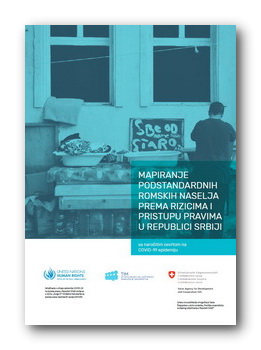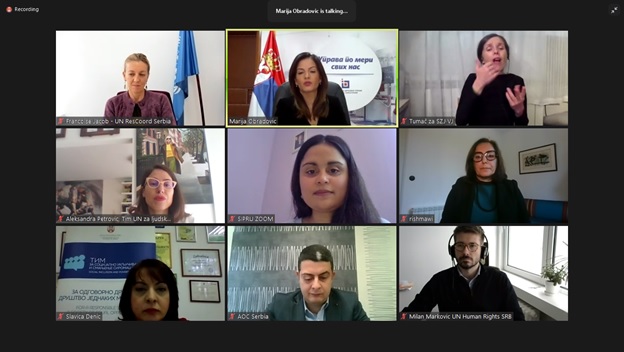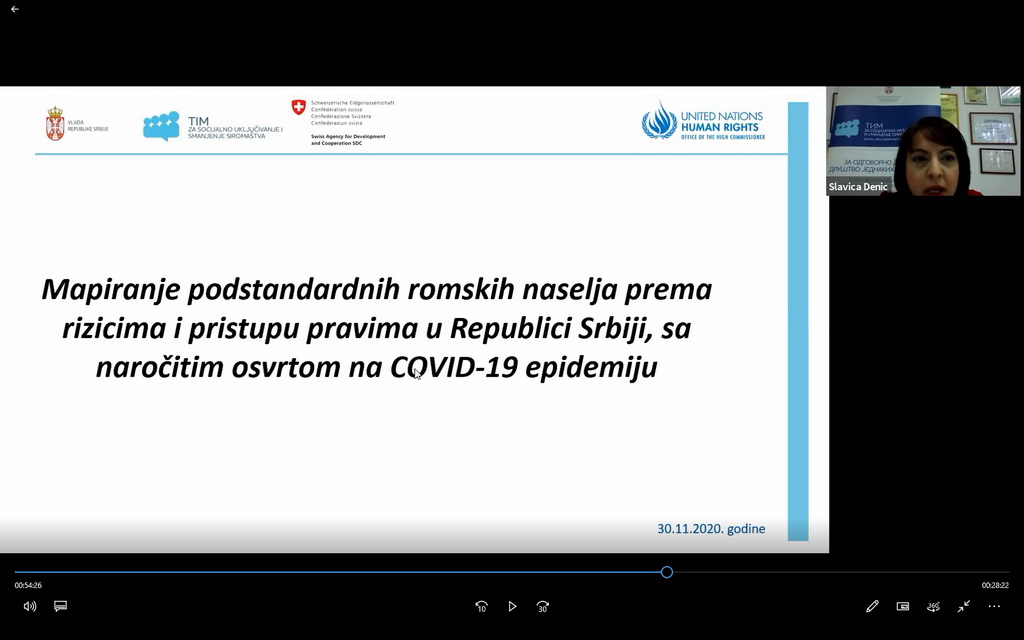 On 30 November 2020, the Social Inclusion and Poverty Reduction Unit of the Government of the Republic of Serbia and the United Nations Human Rights Team, with support from the Office of the United Nations High Commissioner for Human Rights (OHCHR), presented the findings of the “Mapping of Substandard Roma Settlements According to Risks and Access to Rights in the Republic Of Serbia with Particular Attention to the COVID-19 Epidemic”.
On 30 November 2020, the Social Inclusion and Poverty Reduction Unit of the Government of the Republic of Serbia and the United Nations Human Rights Team, with support from the Office of the United Nations High Commissioner for Human Rights (OHCHR), presented the findings of the “Mapping of Substandard Roma Settlements According to Risks and Access to Rights in the Republic Of Serbia with Particular Attention to the COVID-19 Epidemic”.
The mapping exercise was conducted between late March and mid-September 2020 and covered 702 substandard Roma settlements in 92 local self-governments (LSGs) with a population of about 168,000. The mapping findings show that there are 51 LSGs in the Republic of Serbia in which 159 substandard Roma settlements, with a total population of 32,843, have no or irregular access to clean water. Access to sewer networks is irregular or missing in 457 substandard Roma settlements located in 82 LSGs, which are home to 93,050 Roma people. Further, 24,104 Roma living in 64 settlements located in 35 LSGs have no access to electricity.
In the conference introductory address, Serbian Minister of Public Administration and Local Self-Government Ms Marija Obradović said that continuous data collection and analysis was a precondition for planning and effectively implementing measures for the improvement of Roma housing conditions, especially in extraordinary circumstances such as the current crisis. “Recent times have shown that, with adequate insights in the situation, the cooperation with stakeholders and support from international partners, we have the capacity to respond to the urgent needs of the most vulnerable population”, stated Minister Obradović.
“This year has been tremendously challenging in the domain of human rights, as the crisis has fueled new vulnerabilities and threats”, said Ms Françoise Jacob, the United Nations Resident Coordinator in the Republic of Serbia. She explained that special focus in the recent months had been on the persons who were at some form of risk, while Roma housing had been one of the key issues addressed by United Nations agencies in Serbia for many years. “The problems associated with the lack of water and electricity in substandard settlements and the informal jobs that Roma people do for a living have become even more complex during the crisis. Thanks to this mapping, we will be able to plan and intervene more effectively, in order to enhance as much as possible the enjoyment of human rights, social protection and economic opportunities for Roma community”, concluded Ms Jacob.
Ms Mona Rishmawi, Chief of the Rule of Law, Equality and Non-Discrimination of the Office of the UN High Commissioner for Human Rights in Geneva, noted that individuals living in substandard settlements faced the greatest risk and challenge in the implementation of protection measures in the pandemic, including social distancing, access to water, sewerage and electricity. “This mapping is especially significant, since it identifies specific risks faced by Roma population, which could lead to increased exclusion and marginalization and, therefore, this is a valuable database for designing new policies and actions”, said Ms Rishmawi and stressed that policymaking informed by mapping results could accelerate the progress towards the 2030 Agenda, as well as enable better protection of human rights, to ensure that no one is left behind.
According to Mr Dragan Gračanin, President of the Association of Roma Coordinators, despite the large number of studies conducted in Serbia over the years, in the beginning of the crisis it was not possible to determine which Roma settlements in Serbia had access to drinking water, sewerage and electricity. As he explained, the local self-governments that had Roma coordinators made this data available much more easily and quickly, and the research methodology was founded on the concept of human rights. He stressed that this process was not finished and that he expected that the data would be updated in the upcoming period, as well as that the entire document could be further improved through a broad participatory process.
Ms Aleksandra Petrović from the United Nations Human Rights’ Team in Serbia explained that this mapping covered substandard settlements inhabited almost exclusively by the Roma and that the key data referred to their access to drinking water, sewerage and electricity, although the collection of information about the economic activities in which the inhabitants of these settlements engaged was also important in the context of the access to sustainable sources of income. “This is the first research based on human rights and the related Sustainable Development Goals, so the focus of the research was not on the accessibility of infrastructure, but rather on the access to human rights of adequate housing, health care, decent work etc.”, stated Ms Petrović.
Ms Slavica Denić, Roma Inclusion Coordinator at the Social Inclusion and Poverty Reduction Unit of the Government of the Republic of Serbia, said that in 86% of the cases research data was received from the institutional Roma inclusion mechanisms established at the local level. “Where such mechanisms are not in place or the LSGs failed to provide data, the information was collected from the representatives of local (Roma and other) civil society organisations, or from activists (4%), and was verified by cross-referencing with multiple available sources”, explained Ms Denić. She noted that more than 14,000 people living in 44 substandard Roma settlements located in 13 local self-government units had no or irregular access to clean water, sewerage and electricity.
The mapping data constitute a sound basis for planning the measures for recovery and prevention of future risks affecting the most vulnerable Roma groups, updating the Geographic Information System (GIS) maintained by the Ministry of Construction, Transport and Infrastructure, as well as for enhancing current projects and programmes and planning new ones.
 Government of the Republic of Serbia
Government of the Republic of Serbia


















 pdf [271 KB]
pdf [271 KB]
Leave a Comment